Daunting silence. The silent pitch-dark theatre would make an achluophobic shiver in his seat. Yet the Singapore Festival Orchestra waited for the audience to embrace the silence and remain still.
Pockets of people coughing, discreet whispers of “What’s going on?” and the annoying zipping and unzipping of bags (for what absurd reason, UrbanWire) faded eventually.
Full of Anticipation
Minutes of Silence
The Chorus
The Allegory of Fish
Altering Space
The Struggle
Chaos Continues
The Swan Song
Acclaims from UrbanWire
Reactions from the Audience
Full of Anticipation
The Architecture of Silence choreographed by Edward Clug was the first performance of the Singapore Arts Festival 2008 at Esplanade. It drew music-lovers and balletomanes (ballet-lovers) alike. UrbanWire attended the Asian Premiere of the historical ballet that weds Mozart’s “Requiem” and Preisner’s “Requiem for My Friend” – two contrasting pieces often said by music critics to be “incompatible” .
The collaboration between Maribor and Ljubljana is the largest collaboration ever to be seen in Slovenia. The two states are approximately 130km apart which is about an hour and half’s drive by car.
In an interview with UrbanWire, Edward Clug explains that he saw it “not as unification, but as an ensemble”.
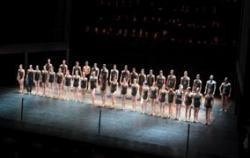 He also told UrbanWire, “It was a big challenge. But I tried to avoid the word ‘big’ the most. I’m used to ballets on a smaller scale of maybe just 6 to 10 dancers. I want to create something intimate despite of the number of people involved.”
He also told UrbanWire, “It was a big challenge. But I tried to avoid the word ‘big’ the most. I’m used to ballets on a smaller scale of maybe just 6 to 10 dancers. I want to create something intimate despite of the number of people involved.”
Building on an idea shared to him by his friend, an arts patron, Clug initially considered Mozart’s “Requiem” untouchable.
He said in the same interview, “Listening to Mozart, I found that his pieces were difficult to touch. I was concerned about using Mozart’s “Requiem” as it doesn’t need visual prolongation; you can experience it just by listening to it.”
The title “Architecture of Silence” came to mind while Clug was analysing the two compositions. “I imagined myself as an architect, shaping the silence into the music. The title is a metaphor, combining the two authors,” the choreographer explained to UrbanWire.
Clug goes on to share his curiosity of the Singaporean audience’s reaction to the ballet, saying, “I presented something unknown, new, incomparable and authentic so I’m only curious about the outcome.”
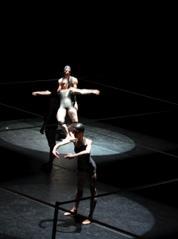 The curtains lifted slowly and steadily, unwrapping and unleashing what lies beyond – a square formed by four black 5-seater sofas. The inner square was lined with the 45-strong corps de ballet from Maribor and Ljubljana standing absolutely still. It’s getting far too eerie for your liking, so you will them to move.
The curtains lifted slowly and steadily, unwrapping and unleashing what lies beyond – a square formed by four black 5-seater sofas. The inner square was lined with the 45-strong corps de ballet from Maribor and Ljubljana standing absolutely still. It’s getting far too eerie for your liking, so you will them to move.The motionlessness of the stage drags on till suddenly you detect sharp
movements from behind the wall of the statue-like figures clad in black and purple: suits for the male dancers and dresses for the female dancers. Is it just your imagination, you wonder? The movements seem to spread like wildfire, soon all the dancers pick up the canon (the same routine done by different dancers at different times) one by one, in their own time and space.
The Chorus
The music creeps in slowly, pervading the silence. From the dark backdrop, reading lights from the chorus shock you as they suddenly light up gradually like glows of countryside houses on a hill.
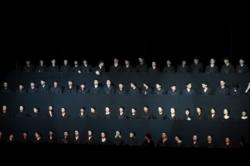 Mozart’s “Introitum” then brightens to the dramatic blast of Mozart’s “Kyrie” . The dance matches the energy of the chorus perfectly as quickens into an almost-chaotic frenzy.
Mozart’s “Introitum” then brightens to the dramatic blast of Mozart’s “Kyrie” . The dance matches the energy of the chorus perfectly as quickens into an almost-chaotic frenzy.
In “Rex Tremendae” , the dancers systemically align into 6 rows where they move almost robotically to the staccato beats of the chorus. Their unity is remarkable, each step requiring unfathomable precision.
UrbanWire notes the outstanding vocals of the 80-strong chorus and four opera soloists.
The Allegory of Fish
Edward Clug explained, in the programme booklet, the symbolism of fish in Architecture of Silence, “These mute creatures carry within themselves the burden of silence – silence not of absence, but a distinctly present silence.”
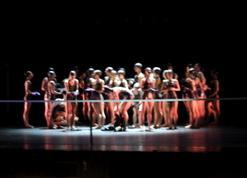 The fish-like quality of the dancers came alive during Mozart’s “Recordare” where the corps de ballet slowly gathered in the middle spotlight, akin to fish gathering at the ray of sunlight peeking through the water surface.
The fish-like quality of the dancers came alive during Mozart’s “Recordare” where the corps de ballet slowly gathered in the middle spotlight, akin to fish gathering at the ray of sunlight peeking through the water surface.By this point, the dancers peel off their dresses and suits to nothing but identical swimming suits and swimming caps
Clug shares with UrbanWire the reasoning behind the identical clothes.
“It gives a sense of homogeneity – now you can’t tell who’s from Maribor or Ljubljana or whether it is a man or a woman.”
Altering Space
Taking the stage by storm, the dancers then literally storm across the length of the stage in a row to the beats of “Confutatis” . For a while, you are distracted by waist-high metal poles on stage. It is only now did you realise its relevance. The principal ballerina walks slowly across the stage,cordoning off 9 areas onstage.
The music stops abruptly to a deathly silence in the eighth beat of Mozart’s “Lacrimosa” , almost denoting the Mozart’s death as an interruption in the manuscript. The ballerina drops a pebble into a half-filled water tank, with the sound reverberating throughout the theatre.
Choreographer Edward Clug told UrbanWire that “the consequence of Mozart’s and Preisner’s silence is the visual space shaped by the human body.”
UrbanWire commends the clever usage of space as the 9 cells that were created remained separate from other spaces, yet the dances in each cell seemed to interweave seamlessly.
 Each cell held either a solo or pas de deux (dance in pairs), celebrating the elongation of the human body within each space – altering, moulding, creating and pushing the spatial limits it was confined to.
Each cell held either a solo or pas de deux (dance in pairs), celebrating the elongation of the human body within each space – altering, moulding, creating and pushing the spatial limits it was confined to.Apart from the rather calm music, the occasional hitting of the thigh and the sound of pebbles hitting the bottom of the water tank disrupts the otherwise dream-like scene.
Spotlights take turns to light up only the areas that are “active”. The duets and solos go on until the pair in the middle struggles against each other, denoting the struggle to live.
 The danseuse (female dancer) crumples and drops to the floor, unmoving. Her death puts out every light and leaves the theatre in silence.A flute’s wail echoes through the dark theatre, the audience obviously shocked by her sudden death.
The danseuse (female dancer) crumples and drops to the floor, unmoving. Her death puts out every light and leaves the theatre in silence.A flute’s wail echoes through the dark theatre, the audience obviously shocked by her sudden death.Accompanied by Preisner’s “Kai Kairos” , the dance then takes on a haunting persona. The lights fade up on a soloist who starts off with her routine.
Slowly, the dancers in the other areas join in the quickening music save for the now-empty black spot where the danseuse had died earlier
While their footwork displayed experience and their bodies, strength and fitness, the whole dance was so physically demanding that when the orchestra stopped playing, you can hear their heavy breaths.
Chaos Continues
Chaos then overturned the stage, complete with red spotlights and a fierce male soloist, who made allegro(quick jumps in the air) seem easy. Finally, the chaos comes to a halt.
It’s back to the light for the “fishes”, first unmoving and almost trance-like before they start to move one-by-one. Visually, it is impactful – a mass of moving human bodies, limbs flying everywhere so that each person is indistinguishable from another. The hitting of thighs continues until a loud thud wakes you from the reverie.
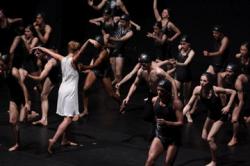 Bodies continue dropping in all directions, as you look on in horror and dismay. It resembles an orchestrated execution of crows – the crows that swoon to their deaths, hitting the ground hard, after being shot down from the trees.
Bodies continue dropping in all directions, as you look on in horror and dismay. It resembles an orchestrated execution of crows – the crows that swoon to their deaths, hitting the ground hard, after being shot down from the trees.

